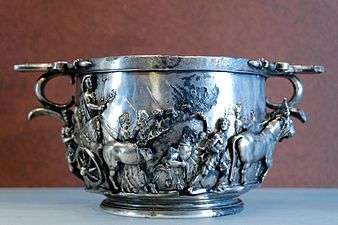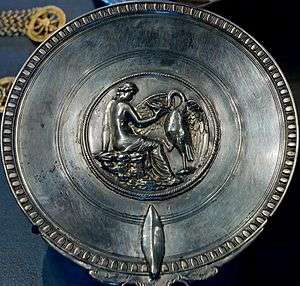Boscoreale Treasure
|
Mirror from the Boscoreale Treasure as displayed in the Louvre | |
| Material | Silver |
|---|---|
| Created | 1st Century AD (mostly) |
| Present location | Louvre, Paris and British Museum, London |
The Boscoreale Treasure is the name for a large collection of luxury Roman objects discovered in the ruins of an ancient villa at Boscoreale, near Pompeii, southern Italy. Consisting of over a hundred pieces of silverware, as well as gold coins and jewellery, it is now mostly kept at the Louvre Museum in Paris, although parts of the treasure can also be found at the British Museum.[1]
History
Located northwest of Pompeii, Boscoreale was the location of a large Roman villa, the Villa della Pisanella, that was destroyed and buried by volcanic ash following the eruption of Mount Vesuvius in 79 AD. On April 13, 1895, the remains of a vaulted box containing the treasure was discovered in the wine-pressing room of the villa. The vaulted box contained silver tableware consisting of 102 items and leather bag full of coins to the value of a thousand gold aurei . It is assumed that the objects were intentionally hidden in the storehouse before the eruption of Mt. Vesuvius in AD 79. The last owner of the silver set was probably a woman named Maxima – a name written on many of the vessels. Many items of precious metal were abandoned in Pompeii and its surrounding area by their owners as they attempted to flee the destruction.
The villa was unearthed during several archaeological seasons, confirming the archaeological hypothesis of a villa rustica covering 1000 square meters with clearly defined residential sector and farm buildings. Most of the Boscoreale Treasure was illicitly trafficked out of Italy and was later purchased by Baron Edmond de Rothschild.
The Boscoreale treasure was purchased by Baron Edmond de Rothschild, who donated it to the Louvre Museum in 1896. Baron Edmond Benjamin James de Rothschild (19 August 1845 – 2 November 1934) was a French member of the Rothschild banking family. Given the number of the items, their weight over 30 kg, their technical quality and aesthetic value, the silver set from Boscoreale is among the most important and most prestigious sets of this period.
The name Maxima is inscribed on many of the vessels from the treasure. Unfortunately, there is still no definitive answer to the question of whether the woman near which the vaulted box was found is Maxima. It is assumed that the owner of the villa and the entire property is L. Caecilius lucundus, a banker from Pompeii, who inherited the wealth of the Julio-Claudian dynasty in Campania, and that he was the father of Maxima.[2]
Description
The treasure consists of 109 pieces of silverware, as well as gold jewellery (necklaces, bracelets and earrings) and over 1000 gold coins. Items from the hoard vary in date from 4th Century BC to 1st Century AD. Many of the silver items from the treasure are considered masterpieces of Roman art that could only have belonged to the very elite sections of society. A few objects also seem to be family heirlooms passed down the generations. Parts of the hoard are inscribed with the name Maxima who were perhaps the original owner. Some of the most well-known items in the treasure include:
- Skyphos cup of Augustus on a military campaign, seated and surrounded by his lictors and lieutenants as he grants clemency to suppliant barbarians. The alternate side of the Skyphos depicts Augustus among Gods such as Venus, Cupid and Mars, who represent four conquered provinces.
- Skyphos cup of Tiberius on a triumphal procession through the streets of Rome. The emperor-to-be rides in a horse-drawn chariot holding a laurel branch and an eagle-tipped scepter. The alternate side of the Skyphos depicts Tiberius sacrificing a bull in front of a temple to Jupiter.[3]
- Two silver cups decorated with skeletons.[4] The two silver cups have similar and complementary repoussé decoration depicting the skeletons of tragic and comic poets and famous Greek philosophers, beneath a garland of roses.[5]
- Pair of kantharoi with squatting boar in relief.
- Pair of dishes with relief medallions of the busts of a man and women (although only the bust of the latter survives)[6]
- Plate with the central medallion showing the personification of Africa.[7] In the center is a bust of a young woman wearing an elephant hide, holding a cobra in her right hand and a horn of plenty full of fruit in her left.
- A polished toiletry mirror with a brilliant reflection, practically this was used to view oneself, the decoration represents the meeting of Leda and Jupiter, turned into a swan, and is a hymn to femininity and sensuality.[8]
- Oenochoe of a goddess sacrificing a bull
- Stemless silver cup with gilded central boss and bands of lotus leaves dating from 300 BC[9]
Roman Gold Aurei from Boscoreale

Boscoreale is also well known to Roman numismatists as the location of a hoard of over 1,000 gold aurei. The aureus (pl. aurei - "golden") was a gold coin of ancient Rome valued at 25 silver denarii and was regularly issued from the 1st century BC to the beginning of the 4th century AD, when it was replaced by the solidus. The aureus was about the same size as the denarius, but heavier due to the higher density of gold (as opposed to that of silver.)[10]
The latest of the Boscoreale hoard, which contained over 1,000 Aurei, dates to AD 79 and was uncovered in 1895. The entire area was buried by the famous volcanic eruption of Vesuvius in A.D. 79, where the towns of Pompeii and Herculaneum were preserved under layers of ash and pumice. The intense heat from Mount Vesuvius imbued all the gold coins with the beautiful red toning that we now see almost 2000 years later. The villa in which the coins were found was undisturbed until 1876, but even then the coin hoard lay undiscovered for almost another 30 years. Unfortunately, no formal study of the Boscoreale coins was made before they were dispersed into the market, and, as is often the case, it is very possible that a list published in 1909 includes material from other finds as well.
See also
- Berthouville Treasure
- Hildesheim Treasure
- A Visual Tour: A closer look at the Tiberius, Augustus Skyphos
Gallery
-

Silver Oenochoe from the treasure on display at the Louvre
-

Skyphos with seated Augustus receiving vanquished barbarians
-

Skyphos with the Emperor Tiberius's triumph
-

Plate with the central medallion showing the personification of Africa.
-

Handle with image of a child's face from an oenochoe
-
Female bust from the silver plate (British Museum)
Bibliography
- D. Strong, Greek and Roman Silver Plate (British Museum Press, 1966)
- S. Walker, Roman Art (British Museum Press, 1991)
- L'argenterie et bijoux d'or du trésor de Boscoreale : description des pièces conservées au Musée du Louvre - Paris, Leroux éditeur, 1903
- Fr. Baratte, Le trésor d’orfèvrerie romaine de Boscoreale, Paris, Réunion des musées nationaux, 1986, p. 35, 65-67 et 91
- G. Richter, Portraits of the Greeks, Londron, 1965, I, p. 67, 132 et 138
- A. Héron de Villefosse, « Le trésor de Boscoreale », Monuments et Mémoires, Fondation Piot, 5, 1899, p. 58-68, n° 7-8
References
- ↑ British Museum Collection
- ↑ "Exhibition "Silver from the Louvre. Boscoreale Treasure" - National Institute of Archaelogy with Museum". naim.bg. Retrieved 2015-11-06.
- ↑ S. Kleiner, Fred (2007). A History of Roman Art: Enhanced Edition. Clark Baxter.
- ↑ Louvre Collection
- ↑ "Boscoreale treasure | Louvre Museum | Paris". www.louvre.fr. Retrieved 2015-11-04.
- ↑ British Museum Collection
- ↑ Louvre Collection
- ↑ "Mirror with baluster handle | Louvre Museum | Paris". www.louvre.fr. Retrieved 2015-11-04.
- ↑ British Museum Collection
- ↑ "Goldberg Coins and Collectibles". images.goldbergauctions.com. Retrieved 2015-11-08.
Coordinates: 48°51′37″N 2°20′15″E / 48.8603°N 2.3375°E
